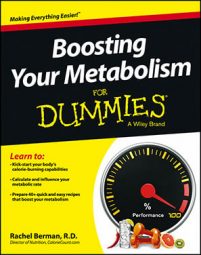Each pigment present in fruits and vegetables is due to a compound that serves up different health benefits. Fruits and veggies provide a more natural sweet fix that’s loaded with fiber, vitamins, minerals, and other metabolism-maximizing goodies.
Aim for 4–5 servings each fruit and vegetable per day:
Fruits: 1 serving = 1/2 cup fresh fruit = 1/2 cup juice = 1/4 dried fruit. (A serving contains 60 calories and 15 grams of carbohydrate.)
Vegetables: 1 serving = 1/2 cup cooked = 1 cup raw leafy vegetable. (A serving contains 25 calories and 5 grams of carbohydrate.)
Check out the nutrients of the color spectrum and pick out at least one or two options per color to incorporate into your diet. For each, the main phytonutrient (the main compound that gives the plant its color) is listed. But each group contains numerous vitamins and minerals, many of which act as antioxidants.
Antioxidants protect your body from damage from free radicals, improve heart health, and according to research can help boost sugar and fat metabolism. The more you add from each color, the better variety you’ll get.
| Color | Fruits/Vegetables | Power Nutrient | Nutrient Function |
|---|---|---|---|
| Red | Red apple, beets, cherries, cranberries, pink/red grapefruit, pomegranate, raspberries, strawberries, tomato | Lycopene | May reduce risk for cancer |
| Orange/Yellow | Apricot, butternut squash, cantaloupe, carrots, orange, papaya, peach, persimmons, pineapple, pumpkin, sweet corn, sweet potato, tangerine | Beta-carotene | Converted to vitamin A for eye health and immunity |
| Green | Artichoke, asparagus, avocado, leafy green veggies, broccoli, Brussels sprouts, celery, cucumbers, collards, honeydew, kale, spinach, zucchini | Chlorophyll | These are chock-full of vitamins and minerals that protect against disease |
| Blue/Purple | Blackberries, blueberries, eggplant, figs, grapes, plums | Anthocyanins | Antioxidants like resveratrol protect cells from damage and improve memory function |
| White | Banana, cauliflower, garlic, ginger, jicama, mushrooms, onions, potato | Anthoxanthins | Allicin can serve to lower cholesterol and blood pressure |
Adding more fruits and vegetables to your day can help you get more caloric bang for your buck. In other words, you can fill up on fewer calories, feel more satisfied, and have more energy due to the fiber and vitamins you’re getting. Fruits and vegetables have a high water content, meaning you take in more volume than you do with denser, nutritionally poor food.
| Meal | Dreary Day | Colorful Day |
|---|---|---|
| Breakfast | 2 waffles, 1 tablespoon syrup | 2 waffles with 1 cup of berries |
| Lunch | Turkey (3 ounces), 2 slices whole wheat bread, 1 ounce chips | Turkey (3 ounces) with lettuce, tomato, 2 slices whole wheat bread, 20 baby carrots, apple with 1 tablespoon peanut butter |
| Snack | 6 ounces yogurt, 2 graham crackers | 6 ounces yogurt, 3 slices dried mango |
| Dinner | 2 slices pizza, 2 garlic knots | 2 slices veggie pizza with whole wheat crust, spinach salad with 1 tablespoon olive oil |
| Dessert | Chocolate pudding | Chocolate pudding with 1 cup skim milk |
| Total Nutrition | 1,400 calories, 10 grams fiber, below needs for vitamins A, C, calcium. | 1,400 calories, 30 grams fiber, meets RDA for vitamins A, C, calcium. |
Making room for fruits and vegetables doesn’t have to break the bank. Here are ideas of how you can add color on a budget:
Go frozen. Frozen fruits and vegetables are less expensive and not as perishable as fresh. They are frozen at peak of ripeness as well, which means they’re likely to retain more nutrition than fresh foods that lose nutrients during traveling and handling.
Go in season. When fruits and vegetables are in season, they’re less expensive. This is another reason why frozen produce is cool, too — you can buy out of season for cheap.
Go local. Fruits and veggies are cheaper at your local street or farmer’s market. At your supermarket, look for deals in the circular, which is typically located as you enter the store.
Forgo prepackaged and precut. Although perhaps more convenient, on top of the cost of the fruit, you’re paying for the labor and materials that go into cutting and packaging these products. If you're not buying frozen, buy whole fruits and vegetables and do the slicing and dicing yourself.

